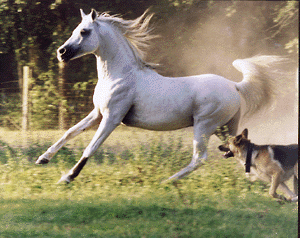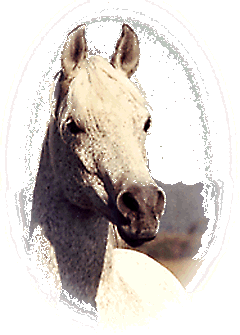| Homer
Davenport was born in Silverton,
Oregon in 1867. At an early age he displayed unusual artistic ability,
which was encouraged by his family. He was to develop his talent to the
extent that he became the foremost political cartoonist of his era. In
1906, this remarkable talent also helped him to fulfill his dream of importing
genuine Arabian horses directly from the desert.
Growing
up at a time when the horse was, for practical purposes, the only means
of transportation, he had early in life developed an interest in Arabian
horses. It was not until 1893 that he first saw real Arabian horses. In
that year, the Hamidie Society of Syria, imported authentic Arabian horses
for display at the Columbian Exposition (Chicago World's Fair). Davenport
was employed as a cartoonist for the Chicago Herald Newspaper at that time.
However, he became so interested in the Arabian horses at the Fair that
he spent all his time there, learning what he could about these fascinating
creatures. In fact, he spent so much time at the Fair that he lost his
job! Talent such as his was not to be denied, and he was shortly thereafter
hired by Randolph Hearst. In 1895, he was transfered to the New York Evening
Journal, and immediately started trying to locate the remnants of the Hamidie
importation which had been sold at auction in 1894. He found most of them
in the possession of millionaire industrialist, Peter Bradley
of Massachusetts.
By
1906, Davenport had acquired a number of Arabians from both Bradley and
others, but he had a dream of personally going to the source. He had read
the informatative books about desert travel and Arabian horses in their
homeland which had been written by English travelers and Arabian importers.
Major R. Upton, Lady Anne and Wilfrid Blunt, and others. He had owned Arabians
for eight years. In other words, he had done his homework. He also had
the financial assistance from Peter Bradley lined up.
There
remained one major problem. At that time, the settled parts of the Arabian
peninsula including modern day Syria, Iraq, Saudi Arabia etc., and even
Egypt were all part of the Ottoman Empire. The Ottoman Sultan, Abdul Hamid
(After whom the Hamidie Society was named), had placed an embargo on the
exportation of Arabian mares from the countries under his rule. Therefore,
it was necessary to get an Irade, or export permit, from the Sultan in
order to obtain any mares. The prospect of an ordinary American citizen
like Davenport being able to obtain an Irade would have been bleak indeed,
were it not for the assistance of the President of the United States. Back
in 1904, during the Presidential campaign, Davenport had met Presidential
candidate Theodore Roosevelt, and had been so impressed with him that he
had changed his own political orientation. Davenport's 1904 political cartoon
showing "Uncle Sam" and Roosevelt with the caption "He's
good enough for me," is largely credited with swinging the vote in
favor of Roosevelt, who was subsequently elected. When Davenport asked
Roosevelt to obtain an export permit from the Sultan, it was quickly done.
Later on, Roosevelt also facilitated the shipping of the horses back to
the States, and he came to see them in 1908.
The
Blunts, Upton, etc., had indicated in their writings that the Anezeh confederation
of Bedouin tribes and the Shammar tribes had the best Arabian horses. These
tribes traditionally migrated to the area which is now northern Syria,
during the hottest season of the year. Davenport and his two companions
left the States in July, thus being able to take advantage of the Bedouins'
annual proximity to the town of Aleppo. Once there, Davenport had the extreme
good fortune of calling on Sheikh Akmet Hafiz, a member of the Anezeh tribe
who served as diplomatic liaison between the Bedouins and the Ottoman governmental
officials in Aleppo. Sheikh Akmet Hafiz felt deeply honored that DAvenport
had contacted him before contacting the local Governor. This was an error
in protocol which served Davenport's purpose beyond any expectations. A
firm friendship developed between the two men, and Akmet Hafiz took on
personal responsibility in assuring that Davenport acquired only the best
of available breeding stock.
During
the past hundred and fifty years or more, many people of diverse nationalities
have acquired Arabian horses in, or from the desert countries. Many, if
not most of these acquisitions were made for the purpose of obtaining horses
to improve local Calvary stock, or other partbred studs. Many were acquired
by people temporarily in the area who simply appreciated good riding horses.
Some exporters relied totally or in part, on governmental agents temporarily
assigned to the area, or bought stock from ageyls ((Arab camel and horse
dealers). The Davenport importation was unusually large, numbering 27,
with ten females. Most important, they were selected with the specific
stipulation, and the Bedouins' oath, sworn to Allah, that they were "asil"
(purebred). These were horses valued by the Bedouins themselves as suitable
for purebred breeding. The importation included representatives of all
the major authentic strains of Arabian horses.
Of
the 27 horses which Davenport imported, 25 were eventually registered,
and 20 are still represented in modern American breeding programs. Fifteen
have straight Davenport descendents living today.
|

